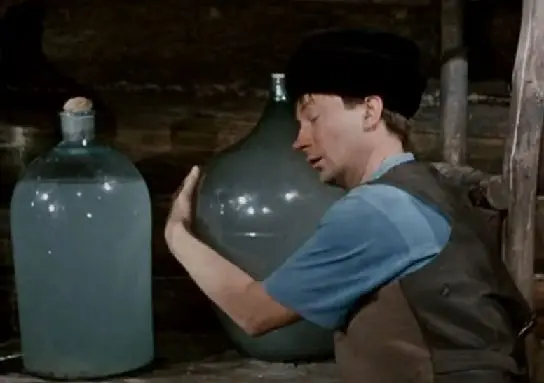Contents
Thanks to domestic films, a stereotype has developed that real moonshine must necessarily be cloudy, or even better, milky white. This is exactly what the rural vodka had about two hundred years ago, it was a terrible swill with a nasty smell.
The peasants made moonshine on primitive handicraft devices, taking the maximum product from the mash, hence the low quality. The nobles, on the contrary, constantly improved the technology and equipment of their distilleries, trying to get a crystal clear distillate of the highest possible strength. There were even competitions between estates and distillers.
After the revolution, the directors of Soviet films considered it right to show on the screen worker-peasant white moonshine of proletarian origin, and not crystal clear “bourgeois” distillate. This tradition has been preserved by Russian filmmakers. Perhaps the reason is that cloudy moonshine looks more spectacular, and it is immediately clear to the viewer what is in the bottle on the table. In any case, it’s time to break this stereotype.


In fact, good moonshine should be transparent. The appearance of turbidity indicates incorrect distillation technology or other problems.
Why is moonshine cloudy
1. Spray blower
The most common reason. When heated too much, boiling mash foams almost like milk. Hot foam through the tube enters the refrigerator (coil) and condenses along with the distillate. Mud appears immediately.
The alembic is closed and opaque, so it is impossible to know if the mash is foaming at a particular point in time. If cloudy moonshine comes out of the apparatus, you need to reduce the heat, finish the distillation (clean the distillate later), disassemble and clean the entire structure.
Preventive measures:
- fill the cube with mash to a maximum of 70% of the volume, leaving room for foam (mandatory);
- monitor the intensity of heating (depending on the apparatus), the correct temperature regime is selected experimentally after several distillations;
- install a steamer (when foaming, the splashes will fall into the jar, and not into the coil);
- thoroughly wash the entire apparatus after each distillation;
- before distillation, drain the mash from the sediment and clean, for example, with bentonite, so that there are fewer impurities that can cause foam.
2. The presence of fusel (essential) oils
Fusel and essential oils are toxic substances (more than 40 types), which are a by-product of fermentation. These substances have a higher or lower boiling point than ethanol, so most (but not all) can be removed from the distillate by fractional distillation (fractionation).
Prevention: so that the moonshine does not become cloudy, you need to cut off the head upper fraction and finish the distillation in time. Cleaning between distillations, for example with charcoal, also reduces the risk of haze.
Usually the turbidity begins after the drop of the fortress in the jet below 40 degrees.
3. Bad moonshine materials
Sometimes cloudiness of moonshine is caused by oxidation of the material from which the body of the apparatus, the coil, connecting tubes or other structural elements are made. It has been noticed that many problems arise due to low-quality silicone. Turbidity may appear immediately or after some time.
Prevention: make (buy) devices only from high-quality materials. Periodically check the elements for oxidation and other defects.
4. Hard water
In this case, moonshine becomes cloudy immediately or a couple of hours after dilution with water. The white color appears due to salts and other impurities contained in the water. The influence of water on the quality of moonshine is very significant and often underestimated by beginners.
Also, do not discount the high concentration of fusel and essential oils in poorly cleaned moonshine (second point).
Prevention: to dilute moonshine without clouding, you need to use only well-purified or bottled water with a minimum salt content. In this case, it is desirable to pour distillate into water, and not vice versa. The recommended temperature of both liquids before mixing is 7-10°C.
5. Unsuitable or poorly washed containers
If you store strong alcohol in plastic bottles, after a while the alcohol will react with the plastic, then the drink will become cloudy. This will release other toxic substances. There is a special plastic for alcohol, but this material is rare in the home. If moonshine becomes cloudy when stored in glass jars, the bottles or jars may not have been washed well.
Prevention: store moonshine only in glass, well-washed and wiped dry containers.
How to clean cloudy moonshine
Only distillate that has become cloudy due to improper distillation technology or dilution with hard water can be purified. If the cause of the turbidity lies in the poor-quality materials of the apparatus or storage in plastic containers, such moonshine is dangerous to health and cannot be filtered, it is better to immediately pour the drink or use it for technical needs.
Cleaning methods
1. The second distillation is the most efficient method. It is necessary to dilute the cloudy moonshine with water up to 18-20%, then overtake again with separation into fractions. Then dilute with high-quality water to the desired strength (40-45%) and keep for 2-3 days in a dark, cool room before use until the reaction is completed and the taste stabilizes.
2. Coal cleaning. Helps in most cases. It is enough to pass cloudy moonshine through a coal column (purchased or home-made) with special coal – BAU-A or BAU-LV brands.
Another method is a filter for water purification of the “Barrier” type, after two or three times the moonshine will become transparent.
3. Heating. It does not always work, the effectiveness depends on the nature of the impurities. The method is used only in extreme cases. Moonshine is heated to 70 ° C, then cooled sharply. After a couple of hours, a precipitate should fall out.
Attention! Heated moonshine ignites quickly.
How to make moonshine cloudy
Lovers of rural color love to drink milk-colored moonshine. I present to your attention the methods that make the drink white, but do not degrade the quality. It is better to paint over the distillate 1-2 days before use, because over time the moonshine exfoliates, and sediment appears at the bottom.
1. Whey. Depending on the desired whiteness, it is enough to pour 5-30 ml of whey into 1 liter of moonshine.
Attention! It is whey that can be added, and not ordinary milk, which often coagulates after reaction with alcohol.

2. Powdered milk. To obtain a white color, it is enough to add 3-15 grams of powdered milk per 1 liter of distillate and mix.
3. Vegetable oil. 2-6 drops of vegetable oil will not spoil the taste of moonshine, but will make it gray. After adding the oil, the moonshine must be shaken well.









